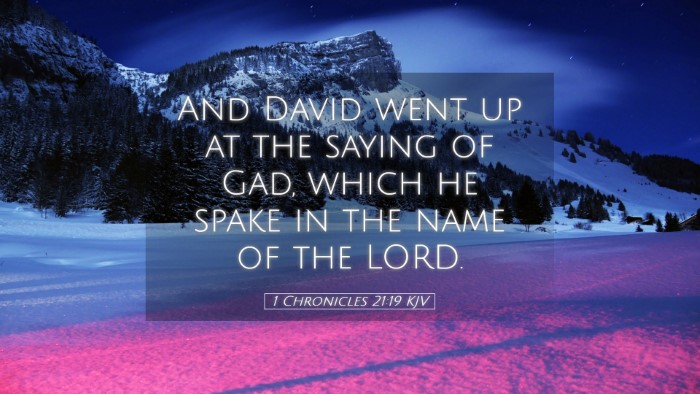Commentary on 1 Chronicles 21:19
Verse Reference: 1 Chronicles 21:19 - "And David lifted up his eyes, and saw the angel of the LORD stand between the earth and the heaven, having a drawn sword in his hand stretched out over Jerusalem. Then David and the elders of Israel, who were clothed in sackcloth, fell upon their faces."
Introduction
This passage occurs during a pivotal moment in David's reign, marked by his sin of numbering the people, which prompted a severe plague as divine judgment. The context of this verse serves both as a call to repentance and an invitation to understand the profound implications of divine justice and mercy. The insights derived from this verse are drawn from several respected public domain commentaries, including those by Matthew Henry, Albert Barnes, and Adam Clarke, providing a comprehensive understanding for pastors, theologians, and scholars.
Contextual Analysis
Matthew Henry emphasizes the importance of understanding the historical and spiritual background of this event. David's sin of conducting a census reflects a reliance on human strength rather than the Lord's provision. This act of pride and presumption sets the stage for the divine response seen in this verse.
Albert Barnes adds that David's action stemmed from a lack of faith in God's ability to sustain His people without numerical assurance. The numbering of Israel was, therefore, not merely administrative but a spiritual misstep with grave consequences.
Divine Encounter
David's Vision
In his commentary, Adam Clarke provides vivid imagery of the moment David sees the angel of the Lord. The angel stands "between the earth and heaven," symbolizing the critical junction of divine justice and human repentance. This visual confrontation serves as a reminder of the spiritual battles that ensue in the heavenly realm, often unnoticed by humanity.
Symbolism of the Sword
The drawn sword of the angel represents judgment. Henry notes that God's judgment is depicted as swift and decisive, yet it also symbolizes the mercy that accompanies divine chastisement. The tension between justice and grace is a recurring theme in Scripture, reflecting God’s nature as both righteous and loving.
Response of David
As indicated in the latter part of the verse, the response of David and the elders dressed in sackcloth illustrates humility and contrition. David's posture of falling on his face signifies a deep recognition of his sin and the gravity of the situation. Barnes observes that this act points toward the necessity of penitence in the face of divine correction.
Henry remarks that the collective action of the elders reinforces the community's role in responding to divine realities. The act of wearing sackcloth symbolizes mourning and seriousness in their approach to God during a time of crisis.
Theological Implications
This passage offers profound theological insights into God’s interactions with humanity. Clarke emphasizes the nature of divine judgment as both a means of correction and an avenue for redemptive grace. God never judges without a reason, and His desire is for His people to return to Him in humility.
Human Responsibility and Divine Sovereignty
Henry elaborates on the theme of human responsibility in the light of divine sovereignty. While David's actions bring about the judgment, the passage teaches that God remains sovereign over the consequences of human actions. The angel’s position between heaven and earth reinforces God's control and the necessity of seeking divine mercy.
Lessons for Today
This verse holds timeless lessons applicable to believers today:
- The Importance of Humility: Just as David and the elders recognized their need for repentance, modern believers are called to humility in acknowledging their frailties and seeking forgiveness.
- Understanding Divine Judgments: Believers are reminded that God's chastening hand is a sign of His love and care, intending to draw them closer to Him.
- The Intercession of Christ: The figure of the angel with a drawn sword serves as a foreshadowing of Christ, who stands as the mediator between God and man, offering grace and forgiveness.
Conclusion
In summary, 1 Chronicles 21:19 is a multifaceted verse that encapsulates the themes of human sin, divine judgment, repentance, and mercy. As David confronts the angel of the Lord, he embodies the struggle of all humanity in recognizing and returning to God amidst our failures. For pastors, scholars, and students, this verse serves not only as a historical account but as a rich source for reflection on the character of God and the necessary posture of the human heart.


